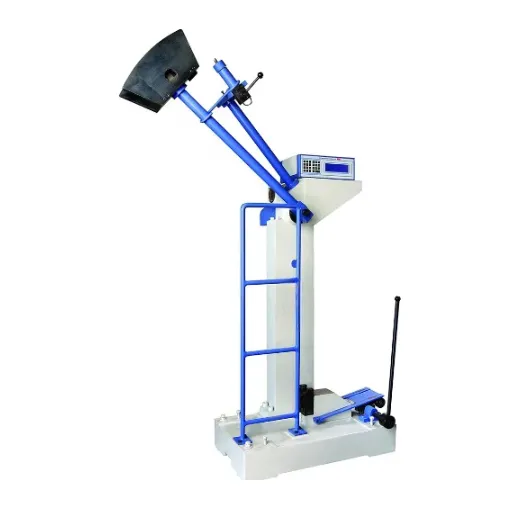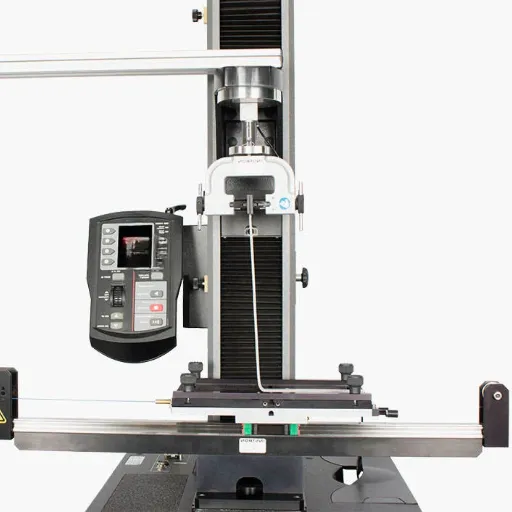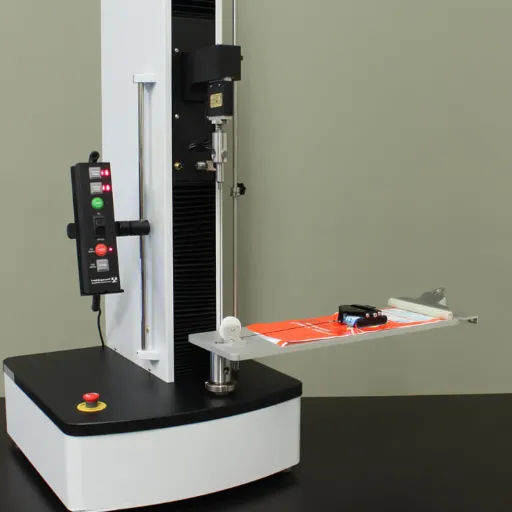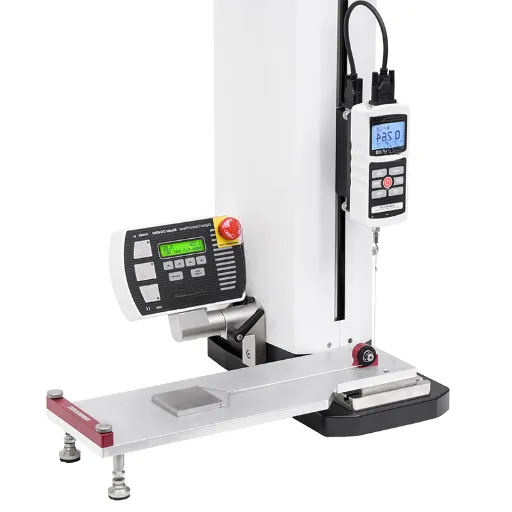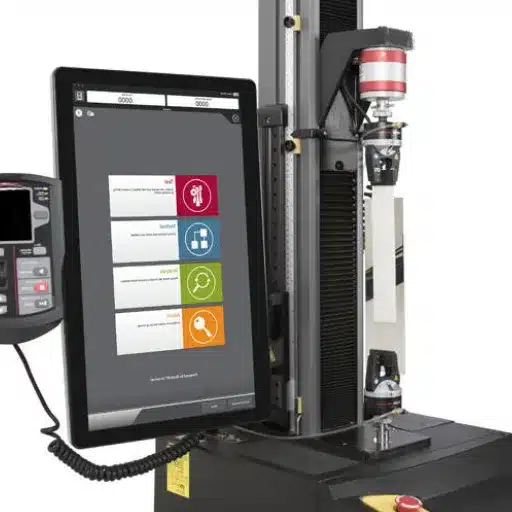Testing impact provides essential information about how a material reacts to a sudden force. It is critical in aerospace, construction, and automotive industries, among others, for safety and efficiency reasons. This article will explain the basics of impact testing, how it is performed, the technology behind impact testing machines, and why tests like these are critical in various industries. You will understand all the procedures and the machinery used for testing the strength of materials and the role impact testing plays in quality assurance processes. Prepare yourself to discover the expertise and exactness behind one of the most effective tools in materials analysis.
What is an Impact Testing Machine?

Definition and Purpose of Impact Testing
Impact testing is a method of testing materials used to estimate a material’s capacity to absorb energy and withstand sudden impacts or shocks without cracking. It is a crucial part of the testing materials undergo to estimate the toughness, strength, and durability of a material, especially under dynamic or shock loading. Impact testing serves the purpose of ensuring that the materials are able to withstand unexpected impacts in the course of their use.
Designed impact testing machines enable the testing process because they simulate and deliver a sudden, controlled force to a test specimen. These machines also deliver the value of the energy absorbed during fracture, which is an indicator of the material’s toughness. With this information, engineers and manufacturers can determine potential weak spots, estimate how the material will fail, and choose the right materials that comply with the required safety and performance criteria. The data is usually collected through standardized tests such as the Charpy and Izod impact tests.
The data obtained from these tested impacts is crucial in sectors like construction, aerospace, automotive, and energy production, where materials are expected to endure harsh conditions. By providing data about how the material behaves during impact, impact testing machines aid in creating more effective designs, better safety protocols, and greater dependability of the final products.
Importance in Various Industries
Impact testing equipment has an essential function in many different areas of business, principally by ensuring that all the materials used in the enterprise satisfy the performance and safety standards stipulated. To illustrate, consider the building sector; such machinery enables the examination of the toughness of materials such as steel and concrete to ensure that these materials can be counted on when facing heavy weights, inclement weather, and accidents. Such analysis enables the engineers to study the materials in order to construct systems that are safe, durable, and reliable over a length of time.
The automotive and the aerospace industries use impact testing machines to test the materials used in the construction of their products, as these materials are required to undergo stress and shocks. The materials of the components of the aeroplanes and vehicles are expected to be of the best quality so as to offer protection to the passengers and the cargo. Ensuring that these materials undergo impact testing is crucial to meeting the appropriate safety standards to eliminate the chances of failures that are critical and to enhance the overall productivity.
Impact testing is of particular concern to the energy production sector, including that of wind turbines, pipelines, and even nuclear power plants. Often, these systems and physical structures are faced with harsh environmental conditions or temperatures, which require internal containment. By studying the performance of materials under sudden force, measures can be put in place to ensure that energy systems function properly and securely, thus reducing failures and expensive downtimes. In essence, impact testing is crucial in different industries for enhancing reliability, safety, and innovation.
Overview of Key Components
An impact tester is an instrument used to measure the impact strength or toughness of a material. The basic components of the impact testing machine include the striker or hammer and the specimen holder. The striker or the hammer impacts the specimen with a sudden force. The specimen holder holds the specimen firmly in place. These systems are necessary to check the behavior of the test specimen under impacts for which it is designed.
The striker or the hammer is the main tool that delivers the energy, the design of which is governed by a specific set of norms. The specimen holder is an important element of the machine since it is designed to hold the specimen steady so that the impact can be delivered properly. To achieve precision and to ensure automatic recording of the energy absorbed by the specimen, contemporary impact testing machines are equipped with measuring sensors.
In addition, these testing machines usually have a control unit or a display unit to capture and analyze the resultant data in a single interface. This function aids in the interpretation of information including the strength or ductility of the material and knowing what changes to apply to the product design or the material. Impact testing machines deliver dependable and consistent results that are needed to develop and design safer and more reliable products because of the integration of all the relevant components.
Types of Impact Testing Machines

Charpy Impact Testing Machine
Charpy impact testing machines offer a practical means for estimating the impact toughness of materials. When a pendulum strikes a notched specimen, the Charpy impact testing machine determines the energy absorbed during fracture. This method is particularly useful in quality control and research and development because it informs on the material’s ability to absorb shock from an unexpected and sudden force.
Its salient benefits include ease of use and quick processing. The device uses a single pendulum to deliver a blow that yields results on impacted materials and provides precise data to evaluate the ductility and brittleness of multiple materials subjected to dynamic loading. Such information is vital in confirming that materials integrated into components, systems, or machines will behave predictably and safely when exposed to high loads or sudden impacts.
The Charpy impact test aligns well with the automotive, aerospace, and construction industries, where the margin for error is minimal. Material weaknesses and susceptibilities enabled by the test direct product engineering and material choice, which enhances safety and dependability. The widespread use of Charpy impact testing machines in various industries stems from their dependability and broad application.
Izod Impact Testing Machine
In the realm of available tools, the Izod impact testing machine offers significant value in analyzing the impact resistance of a material and its energy absorption capacity under sudden impact. With the Izod method, a pendulum slash is used to break a sample with specific dimensions and a notch, and the toughness of the material is evaluated. With these data, engineers and researchers can evaluate the behavior of a material under impact and dynamic load.
This testing method is invaluable in the automotive, aerospace, and construction industries, where parts and components are subjected to sudden and sharp forces and have to resist them. In the Izod test, the sample is placed in a vertical position, and the pendulum is released to break the notched sample. The energy used to break the sample is recorded, and the material can therefore be evaluated. This kind of information is very important in making designs and choosing materials, as it allows one to verify the strength of the material.
The Izod impact testing machine excels in terms of dependability and simplicity of operation, which allows it to be extensively used in quality control and research. The machine is able to identify the weaknesses inherent to a given material and address the concerns that engineers may have in terms of design to make sure that the materials used in products manufactured are safe. It has an essential function in improving the performance of manufactured products as well as their safety because it allows for an accurate assessment of the behavior of materials facing impacts.
Pendulum Impact Testing Machine
The Pendulum Impact Testing Machine is an essential device used to assess the impact resistance of materials. It impacts the test specimen with a pendulum of known energy and determines the energy absorbed thereby. Such a test is critical in assessing the strength of a material and durability in a short time test as it enables the assessment of the material’s behavior under sudden forces, which the material will face in actual applications.
This machine can provide testing for the materials used in the automotive, construction, and aerospace industries, among others. By determining the defects of materials during the testing of prototypes, engineers may be able to improve the safety and dependability of their products. The materials testing ensures that the components used in the critical systems or products comply with the safety materials requirements.
The Pendulum Impact Testing Machine is not only effective but also flexible, as it accepts different specimen sizes and materials. It enables uniform and repeatable testing, thus ensuring that results are dependable and can be compared. This is why it is a necessary tool in the quality assurance and research laboratories, where the study of materials and their responses under impact stresses is essential.
Mechanics of Impact Testing
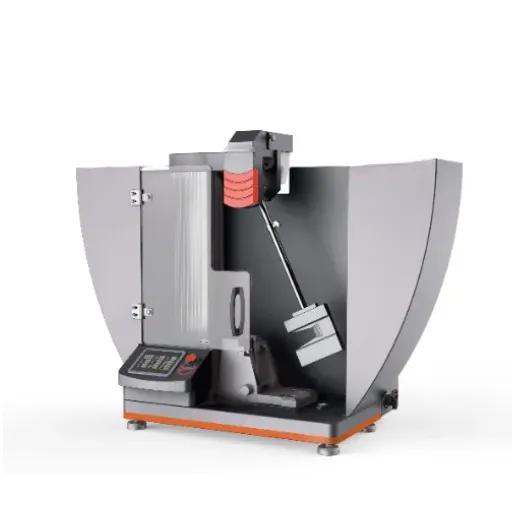
How Impact Testing Machines Work
The impact testing machine operates by striking a specimen with a quick force in order to determine the energy that the material can absorb and the resistance the material exhibits against stress before breaking. Usually, a Hammer machined to resemble a pendulum strikes the specimen, which is firmly gripped. The energy used in striking the specimen and the energy left after the impact are the two energies that the impact testing machine uses to calculate the energy absorbed.
The machine starts the process by lifting its pendulum or striker tool to a predetermined height, thus storing potential energy. Then, the pendulum swings down to hit the specimen, which is placed between the supports. The impact energy transfer to the material causes it to flex or break. The machine calculates and displays the energy absorbed, which is used in determining its toughness, ductility, and brittle failure resistance.
The sudden stress impact on a material is well studied with impact testing machines. It assists different industries in maintaining the safety and reliability of their products. They are used in testing construction materials, automotive, aerospace, or any other materials that require mechanical performance under impact. With the use of these machines, engineers can depend on the uniform results tests yield in order to determine if the material is suitable for use in a specific field.
Breaking Down the Operational Processes
Step-by-Step Process:
- Sample Preparation: A sample is crafted with precision to comply with testing norms. The sample’s size, shape, and surface finish must adhere to the requirements so that the results can be reliably reproduced.
- Sample Positioning: The sample is appropriately fixed in the impact testing machine with extreme care to ensure the data genuinely represents the material’s mechanical properties.
- Force Application: The machine applies a predetermined force or energy to the sample, frequently in the form of striking with a pendulum or letting a defined load act on it.
- Data Collection: Internal machinery sensors and monitors take accurate measurements of energy absorbed, fracture features, and deformation.
- Analysis: The test data is prepared and evaluated to determine strength, toughness, and fracture capabilities of the material.
Such data, as a result of its verification and reliability, is pivotal for the use of the materials in more challenging environments and is subsequently applied in making decisions for product design, quality testing, and safety in numerous industries.
Understanding the Role of Notches and Specimens
The specimens and their notches are critical to the impact testing process because they affect the validity of the test results. A notch is a feature that is intentionally added to the specimen in order to localize the stress in that region. It permits the impact test to quantify the behaviour of the material under a sudden load and to replicate possible failure modes under real life conditions. Through impact testing, a specimen piece with notch geometry defined by a standard is used to allow quantification and ensuring of uniformity of testing. This allows for better comparison of various materials.
Specimens are the pieces of materials to be tested, and they are shaped in accordance with certain dimensional and structural requirements. Such requirements matter a great deal, as they allow testing to be uniform regardless of the industry or type of material being used. Specimens are frequently formed as rectangular or cylindrical bars and may have notches machined to specific angles and depths, as described in the international standards ASTM and ISO. The way a specimen is prepared and its dimensions matter a great deal in the resulting test precision, as deviations in shape or size are likely to impact test results.
As described, notches and specimens in impact testing machines work together to assess mechanical characteristics of metals, such as the toughness and brittle fracture resistance of materials. This kind of data is needed to check the suitability of materials for works in stress-bearing structures. By guaranteeing the specified and standardized conditions, impact testing machines give materials data that is reliable and reproducible, which allows industries to take data-driven actions on materials suitability and safety.
Common Applications Across Industries

Use in Material Durability Testing
Impact testing machines are used to test the ruggedness of materials under sudden forces and shocks. The testing machines reveal important information on the materials’ energy absorption capabilities and their ability to resist fracture when a force is applied to them. This is important for the materials’ intended use where shock and forced impact is expected, such as in the building, manufacturing, and aerospace sectors.
Evaluating the toughness of a material, that is its capacity to deform without fracturing under a certain force, is the main use of the impact testing machines. For instance, in the testing process, metals, plastics, and composites can be subjected to given impact conditions to verify their suitability for use in challenging environments, which assists the engineers greatly. This kind of testing certifies that the materials comply with safety and performance standards by approving the materials to mimic the final application.
Furthermore, reliance on impacts testing results is vital in pinpointing the issues with the materials and the industries to improve the materials’ design and manufacturing processes. The reliable data provided by these machines makes it possible for manufacturers to take appropriate measures, lower the chances of application failures, improve the product life, and ensure the safety and reliability of the products in numerous applications.
Safety and Compliance Standards
Impact testing machines ensure materials meet safety and compliance standards by testing their ability to endure sudden impacts, which is necessary to comply with industry regulations and avoid failures in critical applications. Impact tests ensure materials conform to standards through real-world testing protocols, such as those from ASTM and ISO guidelines.
Industries like construction, aerospace, automotive, and others have to follow these guidelines because of the safety and dependability issues involved. Impact testing guarantees that materials meet their intended performance requirements, saving the end user and preserving product quality. Ongoing testing helps tighten regulatory controls as well as maintain consumer confidence.
Additionally, information garnered through impact testing allows companies to adequately prepare proof of compliance. It is common and advantageous to keep detailed documentation showing that all safety measures are met, especially when dealing with audits, certifications, and even legal questions. This not only helps confirm materials are dependable but also helps encourage continuous improvement throughout the respective industries.
Case Studies: Real-World Applications
Automotive Sector
Impact testing machines are crucial for the automotive sector since they allow for the conduct of safety tests on various car components, such as bumpers and chassis. By performing tests using these components, automotive manufacturers can gain data related to materials’ performance. This data is essential for enhancing the vehicle’s overall impact resistance. Furthermore, using impact testing data enables automotive manufacturers to adhere to safety regulations, minimize recalls, and ensure greater safety for consumers.
Construction Sector
Impact testing is essential for the construction sector as it helps prove the strength of system materials like steel, concrete, and composite panels. Contractors and architects rely on such testing for wired and concrete data in their designs so as to be sure the structures would withstand shock, such as wind or falling objects. For example, testing for impact resistance of doors and windows is vital for the design of buildings located in hurricane zones. All these practices are essential for the assurance of safety in the structural codes and also for reassuring the clients and users of the property.
Manufacturing of Sports Equipment
Impact testing machines are used by sports gear companies to test the safety and performance of helmets, pads, and even face shields. Such testing is necessary to ensure that shock absorption devices work as expected and that the gear provides the necessary protection and safety to the athletes. Gear manufacturers not only enhance the safety of their products by testing their designs against impact data, but they also build trust with their customers, which is important for compliance with regulations.
Advancements in Impact Testing Technology

Emerging Trends in Testing Equipment
For the latest developments in safety equipment testing, impact testing machines lead the way. Using these machines, one can accurately test how a material or a product behaves under sudden forces. The impact testing machines assist manufacturers in evaluating the safety, durability, and elasticity of their designs by simulating real impact scenarios. Consequently, impact testing machines are essential safety and protective gear testing devices as they provide reliable and reproducible results.
Key Technology Advancements:
- Data Precision & Automation: Sophisticated analytics, real-time data collection, and modern sensors provide deeper insights
- Reduced Human Involvement: Enhanced automation cuts down on errors and provides faster, more consistent results
- Advanced Materials Testing: Capability to test diverse range of materials and product designs including high-performance composites
- Industry Adaptability: Enhanced versatility for sports, automotive, and aerospace industries
Another notable advancement is the capability of impact testing machines to cater to a more diverse range of materials and product designs. New high-performance and lightweight composites are increasingly being employed in protective equipment, and these testing machines must now accommodate various material types, dimensions, and shapes. Such adaptability guarantees that testing remains appropriate as manufacturing methods advance, which in turn, fosters the creation of safer products that push the boundaries of innovation from different industries.
Future Directions in Impact Testing
The future of impact testing looks like it will be more precise and automated. With robotic systems and AI, not only can testing be made faster, but the results can also be more accurate. Impact testing machines that incorporate these systems can reduce the chances of human errors, improve repeatability, and handle complex material testing. This advancement helps to maintain a better level of safety and dependability in industries.
Another primary focus is the development of sustainable and environmentally friendly testing methods. Impact testing machine manufacturers are investigating the application of energy-efficient methods and recyclable materials. The alignment of testing methods with sustainability practices must be ensured, especially because of the rising concern of industries towards sustainability. This development not only helps sustainable industries grow but also aids in reducing the environmental impact of the testing methods.
Lastly, impact testing machines are evolving in adaptability and customization. Industries today use innumerable types of materials and designs in aerospace, consumer electronics, and other advanced sectors. Future machines need to be capable in terms of versatility to fulfill the different testing needs while delivering steady performance. With ongoing improvements focused on this, impact testing can continue to be of great assistance to, and impact, a fast-changing world.
Impact Testing in New Sectors
Emerging sectors underscore the significance of impact testing as they grow. For example, robotics, self-driving vehicles, and renewable energy industries use impact testing to verify the endurance and functionality of their parts. This is evident in the use of wind turbine blades and solar panels, which must pass tests for resistance to wind, hail, and extreme heat and cold. In the same vein, materials for self-driving cars must be tested for safety in case of collisions and other unforeseen impacts.
Medical technology is another critical field of application. With the increasing use of advanced prosthetics and implants, impact testing becomes vital to verifying the products’ ability to endure the stresses of real-world use. For instance, to guarantee patient safety and comfort, artificial joints undergo impact testing to make sure they do not fail due to repetitive stress. The accuracy of today’s impact testing machines makes it possible for producers to comply with the rules and meet the high standards demanded of them.
In addition, the space exploration industry is now using impact testing to confirm the durability of the different parts of a spacecraft. From the protective shields that must withstand micro-meteoroid impacts to the modules that must operate in tough space environments, all the parts undergo demanding testing. Impact testing machines that can simulate harsh environments enable researchers and engineers to maintain innovation while protecting the highly specialized materials and designs. As these industries progress, impact testing will be instrumental in advancing safety, performance, and innovative solutions.
Frequently Asked Questions (FAQ)
Q: What Is an Impact Testing Machine?
An impact testing machine is specialized equipment used for materials engineering and quality control. With an impact testing machine, engineers can ascertain both the impact strength and the toughness of a material by subjection to impact forces of defined parameters under specific conditions.
Q: What is the Charpy test?
The Charpy test is a widely accepted procedure for determining the energy a fractured material absorbs. The calculation of the absorbed energy is made by hitting a notched specimen with a swinging pendulum, from which the energy lost is measured, thereby giving the material’s toughness characteristics.
Q: How does a pendulum impact tester work?
The specimen is tested using a pendulum that swings down and strikes it. By measuring the pendulum’s height before and after the collision, the energy absorbed by the specimen is calculated. This provides an indicator of the specimen’s impact resistance.
Q: What is the purpose of impact testing?
Impact testing is carried out in order to obtain the impact resistance and the toughness of a material. With this information, engineers can identify the materials best fitted for use in applications where the materials are subject to sudden, sharp forces. This is critical for ensuring the materials perform well and for providing safety.
Q: What are drop weight testers?
Drop weight testers are a type of drop weight testing equipment. Drop weight testing involves dropping a specified weight from a predetermined height on a specimen. Drop weight testers are used to assess a material’s response to this type of impact.
Q: What distinguishes the tensile impact test from the dynamic tear test?
The tensile impact test is aimed at understanding a material’s performance on tensile loads with impact, while the dynamic tear test evaluates the energy consumed in a high-speed tear action. Both of these tests are useful to understand the performance of materials under impact-related working conditions.
Q: Does impact testing assist in evaluating brittle materials?
Indeed, impact testing is useful in analyzing brittle materials since it gauges how brittle materials resist deformation brought about by impact loads. The Charpy and Izod tests, for instance, evaluate brittle materials and provide useful data on their response to sudden impacts.
Q: What are the accepted procedures for impact testing?
Impact testing procedures are different for different materials and their intended use, but they normally follow certain procedures like ASTM and ISO. Such procedures make sure that the results obtained from different testing equipment and different methodologies are comparable.
Q: What is an instrumented impact test?
An instrumented impact test is an advanced testing method that makes use of sensors and data acquisition systems that enable measurements of energy as a function of time during the impact to be done with much higher precision. Such testing methods not only provide tests results with a much higher level of detail but also enable additional performance-related details of the tested material to be discovered.
References
- Impact Testing Explained: Methods, Applications, & Benefits – Dewesoft
Provides an overview of impact testing, its methods, and applications. - Impact Testers & Charpy Impact Testers – ZwickRoell
Explains the use of impact testing machines for material resistance under rapid loads. - Impact Testing – Instron
Details the process and purpose of impact testing, including energy absorption measurements. - Understanding the Science Behind an Impact Testing Machine
Focuses on the science and mechanics of impact testing machines.

